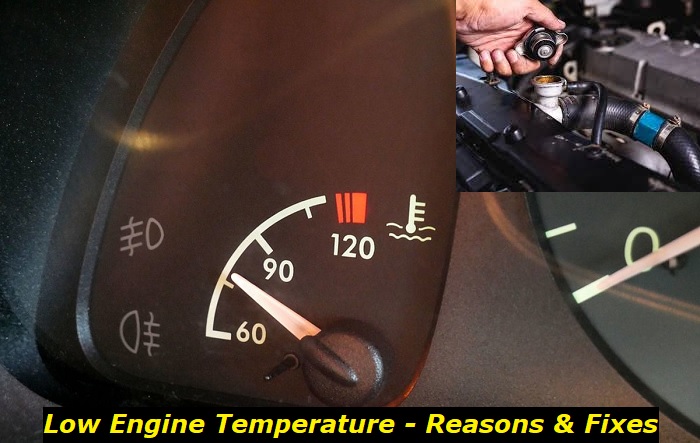It's common knowledge that engines run at high temperatures. If you've ever had to replace your coolant, then you're familiar with the hazard that overheating poses to a car engine. However, it's also possible that you might have noticed your engine is running at a lower temperature than usual. Does low engine temperature pose any threats to the engine like overheating does, or is it something that can be ignored?
Engine overheating highlights
- Level of urgency:very high
- Commonreasons:low coolant, thermostat problems, coolant blockage, radiator fan problem
- DIY diagnostics:possible but complicated
- DIY repair:impossible
- Price of repair:$300 - $650
- Time for repair:3 - 6 hours
- If ignored:engine failure, low performance, cooling equipment damage

Why Is My Engine Temperature Low?
A low engine temperature is usually caused by a problem with the car's cooling system and thermostat. Generally, it indicates a problem with your car's temperature regulation which leaves the cooling system active even when the engine does not need to be cooled down.
Here are some of the common causes of a low engine temperature in your car.
1) Thermostat is Stuck Open
The thermostat is an important part of your car's cooling system. It acts as a temperature-controlled gate between the radiator and the engine. When the engine temperature is too high, the thermostat opens up to allow coolant to flow between the engine and radiator to dissipate heat. On the other hand, it closes to restrict the flow of coolant when the engine is too cold.
When the thermostat goes bad, it can get stuck in the open position or the closed position. When the thermostat is stuck in the open position, coolant will flow through the engine at all times, even when it is cold. This prevents the engine from heating up to its optimal temperature, keeping the engine colder than it needs to be.
2) Faulty Temperature Gauge
The temperature gauge on your dashboard's gauge cluster keeps you informed of the engine temperature. This gauge lets you know whether your engine is overheating or running too cold.
Sometimes the gauge might give the wrong reading, such as reporting a cold engine even when the engine temperature is normal. This might happen as a result of faulty wiring, an incorrectly installed gauge, or the gauge getting stuck.
3) Radiator Fan is Stuck On
One of the ways your engine manages its temperature is by using the radiator fan to cool down the coolant in the radiator. The coolant removes heat from the engine as it flows through it. The hot coolant then flows through the radiator to be cooled down.
When the car is moving at high speed, the air being pulled through the grille is usually sufficient to cool down the engine. In this case, the radiator fan will turn off.
However, electrical problems with the fan, or a faulty sensor, can cause the radiator fan to remain on, even when it is not needed. When this happens, the cooling system will remove too much heat from the engine, resulting in low engine temperature.
4) Cold Weather
A common cause of low engine temperatures is cold weather. Your engine is affected by the ambient heat of the environment, and cold weather can result in low engine temperature. This is especially common shortly after starting your car.
What Are the Effects of Low Engine Temperature?
A car engine is a marvel of technology that is made up of several systems that are engineered to work under certain specific conditions. Your car has many other systems that are built to maintain optimal operating conditions for the engine.
One of the most important operating conditions for your car is the temperature. Car engines produce a lot of heat, so the cooling system must work well to eliminate excess heat. However, your engine has an optimal temperature range, and an overactive cooling system can result in your engine running too cold.
While a cold engine isn't at risk of immediate catastrophic damage like an overheating engine, there are still some problems and potential issues that arise from low engine temperatures.
1) Reduced Performance
The ignition system of your car works most efficiently within a certain range of temperatures. If the engine is too cold, the fuel that enters the engine might not combust fully. Incomplete combustion will result in a loss of power. You might notice sluggish acceleration and a less responsive accelerator pedal.
2) Reduced Fuel Efficiency
Incomplete combustion caused by a cold engine results in fuel wastage. If you continuously drive with low engine temperature, you might notice that you need to fill your fuel tank more often than normal.
3) Hard Starting
Drivers that live in cold areas will be familiar with how hard it is to start a car in cold weather. When the engine temperature is too low, it makes it difficult for the fuel to combust efficiently. This causes difficulty when trying to crank the engine and start the car.
4) Increased Exhaust Emissions
Incomplete combustion in the cylinder allows unburned fuel to escape the engine into the exhaust system. Unburned fuel in the exhaust system results in increased emissions and can cause damage to the catalytic converter.
5) Increased Engine Wear
One of the reasons the engine needs to be warm is to allow the engine oil to heat up sufficiently. Engine oil tends to be thick and viscous when it is too cold. Cold engine oil won't allow the engine to build up the required oil pressure, and the oil won't flow freely to the parts of the engine where it is needed.
This results in low oil pressure and oil starvation. This causes wear and tear in the engine if the engine is allowed to run in this condition for too long.
How to Deal with Low Engine Temperature?
Low engine temperature is an issue that is best dealt with promptly. While the engine usually isn't at risk of immediate damage, prolonged driving with a cold engine can result in the engine developing premature wear as a result of oil starvation. It also causes a reduction in performance and an increase in emissions, both of which are annoying issues that affect your use of the car.
Here are some of the ways you can deal with low engine temperature.
- Allow the Engine to Run for a While
If you feel that your low engine temperature is caused by cold weather, you don't have to do anything drastic to fix it. Simply allow your engine to idle for about three minutes. This allows the engine to warm up a little so the oil can start to circulate. After three minutes you can start driving. Driving the car increases the RPMs and allows the engine to come to the correct temperature more quickly.
If the engine temperature is still low after a few minutes of driving, then there might be a problem with the car's cooling system.
- Check the Radiator Fan and Wiring
If the radiator fan is constantly on, even when the car is moving at high speed, then there is probably a problem with the radiator fan. A faulty radiator fan will need to be replaced or repaired.
A certified automotive electrician can take a look at the radiator fan to find out if the fan is faulty, or if there is a problem with the wiring harness or one of the cooling system sensors that need to be fixed.
- Replace a Faulty Temperature Gauge
If the engine is consistently reporting a low temperature, but you don't notice signs of a cold engine, then you might have a problem with the temperature gauge. A bad temperature gauge could report a low temperature even when the engine is running hot.
The easiest way to solve this problem is to have the temperature gauge checked. If the gauge itself has gone bad, then it will need to be replaced.
It is also possible for the problem to stem from faulty gauge wiring. If this is the cause of the problem, then the gauge will need to be rewired. In some cases, the entire gauge cluster might need to be rewired.
- Replace a Faulty Thermostat
If the thermostat is stuck in the open position, the entire cooling system will be compromised. To get the cooling system working again, the thermostat will need to be replaced.
Conclusion
Sometimes you might notice your engine is running colder than usual. When this happens, it is usually a result of a problem with the car's cooling system. A cold engine is not as urgent a problem as an overheating engine, but it still needs to be dealt with as soon as possible. This is because running your engine below the optimal temperature for too long puts it at risk of developing premature wear.
Dealing with a cold engine usually involves replacing a faulty thermostat, radiator fan, or temperature gauge.
About the authors
The CarAraC research team is composed of seasoned auto mechanics and automotive industry professionals, including individuals with advanced degrees and certifications in their field. Our team members boast prestigious credentials, reflecting their extensive knowledge and skills. These qualifications include: IMI: Institute of the Motor Industry, ASE-Certified Master Automobile Technicians; Coventry University, Graduate of MA in Automotive Journalism; Politecnico di Torino, Italy, MS Automotive Engineering; Ss. Cyril and Methodius University in Skopje, Mechanical University in Skopje; TOC Automotive College; DHA Suffa University, Department of Mechanical Engineering






Add comment